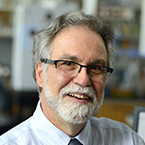
For his revolutionary, Nobel Prize-winning contributions to uncovering the molecular mechanisms of oxygen regulation within cells and for discovering hypoxia-inducible factor 1, critical for cellular adaptation to changing oxygen levels, which has had far-reaching implications for the treatment of numerous diseases characterized by low oxygen levels, including diabetes, heart disease, and cancer.
Internationally heralded, Dr. Semenza has made groundbreaking contributions toward uncovering the molecular mechanisms of oxygen homeostasis. He is best known for his discovery of hypoxia-inducible factor 1 (HIF-1), which plays an essential role in cellular oxygen sensing. Dr. Semenza investigated the molecular mechanisms regulating the expression of the gene encoding erythropoietin (EPO) which controls red blood cell production. He delineated regulatory sequences required for human EPO gene expression in the kidney and liver of transgenic mice. He also identified a 33-base-pair hypoxia response element (HRE) that is required for increased EPO expression under hypoxic conditions, and found a protein that was present selectively in the nuclei of hypoxic cells that bound to the HRE, which he designated hypoxia-inducible factor 1 (HIF-1). Purification of HIF-1 revealed that it was composed of an O2-regulated HIF-1a subunit and a constitutively expressed HIF-1b subunit. HIF-1a accumulated when cells were exposed to low O2 conditions and was rapidly degraded upon reoxygenation.
Dr. Semenza subsequently uncovered many other genes regulated by HIF-1, including vascular endothelial growth factor (VEGF), a critical protein for blood vessel formation. He showed that HIF-1a knockout in mice led to to defects in development of the heart, blood vessels and red blood cell production leading to embryonic lethality. HIF-1 also plays a critical role in cancer progression. HIF-1a levels are associated with mortality in many types of cancer. HIF-1 controls O2 delivery by stimulating angiogenesis and O2 consumption by regulating the balance between oxidative and glycolytic metabolism. HIF target genes also play key roles in invasion, metastasis, cancer stem cell maintenance, chemotherapy resistance, and immune evasion. The importance of HIF-1 for cellular adaptation to changing oxygen levels is now a fundamental concept in cell biology with far-reaching implications for the treatment of numerous diseases characterized by low oxygen levels, most notably cancer.
Selected Awards and Honors
2019 Nobel Prize in Physiology or Medicine
2018 Massry Prize, The Meira and Shaul G. Massry Foundation, Beverly Hills, California
2017 Discovery Award, Society for Redox Biology and Medicine, Indianapolis, Indiana
2016 Albert Lasker Basic Medical Research Award, New York, New York
2014 Wiley Prize in Biomedical Sciences, Hoboken, New Jersey
2012 Elected Member, National Academy of Medicine, Washington, DC
2010 Canada Gairdner International Award, Gairdner Foundation, Toronto, Canada
2008 Elected Member, National Academy of Sciences, Washington, DC
2008 Elected Member, Association of American Physicians, Belleville, Michigan
2005, 2010, 2013 Annual Program Committee, American Association for Cancer Research, Philadelphia, Pennsylvania
2005 17th Annual Donald Ware Waddell Award, Arizona Cancer Center, Tucson, Arizona
2000 E. Mead Johnson Award for Research in Pediatrics, Society for Pediatric Research, The Woodlands, Texas
1995 Elected Member, American Society for Clinical Investigation, Ann Arbor, Michigan
1993 Elected Founding Fellow, American College of Medical Investigation, Bethesda, Maryland